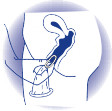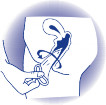Oxford Handbook of Midwifery (119 page)
Read Oxford Handbook of Midwifery Online
Authors: Janet Medforth,Sue Battersby,Maggie Evans,Beverley Marsh,Angela Walker

- After caesarean section
: wait at least 8 weeks to allow uterine muscle healing. If breastfeeding, the above applies. - The IUD will be inserted by a doctor or nurse trained in the technique.
- Ideally insertion takes place at the end of a period, when the cervix is more receptive to facilitate insertion.
2
Pre-insertion infection screen - Prior to insertion it is good practice to check for any current evidence of infection that could be extended into the uterine cavity with insertion. Explain this to the woman.
- The vagina and cervix are inspected and endocervical swabs taken for
Chlamydia
and gonorrhoea and a high vaginal swab for other infections such as bacterial vaginosis. Ideally this is done, and results are known, so that any infection can be treated before the IUD is inserted. - In the case of emergency post-coital contraception, the swabs are taken at the time of insertion and infection subsequently treated, if necessary.
CHAPTER 22
Contraception552
Insertion
- This is an aseptic procedure throughout.
- It is normal practice to apply lidocaine 2% gel around the cervix prior to the procedure. This not only reduces any discomfort felt, but also helps to relax the cervix during uterine sounding and IUD insertion.
- It also helps to advise the woman to take some simple analgesic, such as paracetamol or ibuprofen, about 1h prior to her appointment.
- 2 The woman’s colour and pulse rate are monitored to detect any evidence of shock.
- Once inserted, the monofilament threads are trimmed to approximately 3cm outside the cervix.
- At follow-up, 4–6 weeks later, the threads are further trimmed to 1cm. outside the cervix.
Teach the woman to feel for the threads after every period, to ensure that the device remains
in situ
. If she cannot feel them she should return to the clinic where the IUD was inserted.Advantages
- Provides long-term, highly effective, reversible contraception.
- It is immediately effective.
- It is not related to intercourse.
 •
•
There are no tablets to remember. - Very low morbidity.
- Once removed, the woman’s fertility immediately returns to normal.
Disadvantages
- Periods may be longer, heavier and more painful, particularly the first couple of days.
- The woman may experience inter menstrual bleeding or spotting, particularly in the first 3 months.
- Infection: a small percentage of women may develop a pelvic infection, particularly in the first few weeks after insertion, which should be treated promptly with appropriate antibiotics. Pelvic infection is more likely in younger and nulliparous women and in those who are at risk of sexually transmitted infections.
Follow-up
- Usually the first appointment is at least 1 week after the next expected period, or up to 3 months, depending on local policy.
- This is to ensure that the IUD is comfortable, with no pain or discomfort; that there is no evidence of infection, that no part of the IUD can be felt or seen in the cervical canal; and to trim the threads once the IUD is settled in position.
- It is important to advise the woman to keep her follow-up appointments, even though she may not be experiencing any problems with her IUD.
Removal
The IUD is usually removed during a period. If removed later in the men- strual cycle, advise the woman to use an additional contraceptive method for 7 days prior to removal, to avoid possible pregnancy.
INTRAUTERINE DEVICES
553
Problems with the IUD
Most problems occurring after IUD insertion can be attributed to faulty insertion technique:
- This is an aseptic procedure throughout.
- Failure to check the position and length of the uterine body, and obstructions in the uterus, such as submucous fibroids or septate or bicornuate uterus.
- The actual insertion technique was faulty.
Infection
Symptoms of infection may include pain during or after intercourse, unusual vaginal discharge, irregular bleeding, and lower abdominal or back pain.
Actinomyces-like organisms may be found in the genital tract of women with an IUD inserted. These potentially threaten future fertility and may be life-threatening if untreated.
0 If any signs or symptoms of infection, such as abnormal vaginal discharge, pain, dyspareunia, tenderness, the woman must be immediately referred to a doctor for investigation and treatment. Ideally, this should be at a contraception and sexual health clinic. The IUD may have to be removed.
Bleeding
- Intermittent bleeding and spotting may occur for the first two or three

cycles after insertion, after which it normally settles down.
- Warn the woman that this might occur.
- Periods may be heavier with an IUD fitted.
Ectopic pregnancy
It is a myth that an IUD will cause ectopic pregnancy. The main cause is infection of the fallopian tubes, with one or both tubes being affected. The IUD is highly effective at preventing uterine pregnancy and very few sperm actually penetrate the copper containing uterine fluid to reach the egg in the fallopian tube to be able to cause fertilization.
1Points to remember
- A modern copper-bearing IUD is a highly effective form of short- or long-term contraception, with an efficacy rate of over 99%. IUDs now on the market can have a copper efficiency of up to 10 years.
- Know her history for contraindications before advising a woman about an IUD.
- It does not cause abortion.
- Advise her about insertion after abortion or birth, particularly if breastfeeding.
- It is more effective than the oral form of emergency contraception, particularly between 3 and 5 days after intercourse in the fertile period of the woman’s menstrual cycle.
- More effective in women <30.
- An infection screen is good practice, wherever possible, prior to IUD insertion.
CHAPTER 22
Contraception554
- Advise her to take a simple analgesic about an hour before planned insertion, which will help with discomfort during insertion and any lower abdominal cramps in the hours after insertion.
- Advise the woman of the importance of checking for her threads after every period. If she cannot feel them, the doctor will check and an ultrasound scan will be advised to locate the IUD, if necessary.
- Advise her of the importance of attending follow-up appointments.
- Advise her to report any signs and symptoms of infection promptly, to prevent any possible long-term damage to her reproductive tract.

1
Guillebaud J (2008).
Contraception Today
, 6th edn. London: Taylor and Francis.This page intentionally left blank
CHAPTER 22
Contraception556
Female condom
- The female condom (Fig. 22.6) is a well-lubricated, loose-fitting polyurethane sheath, with an outer rim, designed to keep the condom outside the vagina in use, and a loose inner ring, with a retaining action similar to the diaphragm, designed to fit behind the suprapubic bone and over the cervix.
- It is easy to obtain over the counter, as well as at contraception and sexual health clinics, and does not need medical supervision. It is made in one size only and full instructions are contained in the packet. Each condom is individually packaged; they come in packs of three and each condom is single use only.
How is it used?
- For effective use it must be used before there is any genital contact. Remind the woman that, before opening the packet, she should push the condom well away from the edge of the packet that is to be torn to release the condom.
- The condom is inserted into the vagina, using the inner ring as a guide, as far as possible along the posterior vaginal wall towards the posterior cervical fornix. The outer ring lies flat against the body, outside the vulva, which helps prevent the condom being drawn up
 into the vagina during intercourse. It can be inserted any time before
into the vagina during intercourse. It can be inserted any time beforesexual intercourse and when correctly in place it will feel loose and comfortable. The man needs to be careful that the penis is not inserted between the condom and the vaginal wall. After use it should be carefully disposed of and
not
flushed down the toilet. - Additional spermicides or lubricants of any kind can be used, although this should not be necessary, as the condom is very well lubricated.
Advantages
- The condom, when used carefully and consistently, is extremely effective in preventing pregnancy.
- Similarly, it is effective in preventing sexually transmitted infections and HIV.
- It is easy to obtain and use and requires no medical supervision.
- It does not require additional spermicide.
- It can be used with oil-based products.
- Polyurethane is stronger than latex. It is much less likely to split or break in use than the male condom.
- It does not require male erection before use.
- It may protect the woman against cancer of the cervix, by preventing transmission of HPV.
- The woman can take responsibility for contraception and STI prevention.
Disadvantages
- It needs forward planning each time.
- It needs to be used carefully to be effective.
- It can interrupt sex.
- It can get pushed into the vagina during intercourse.

Insert the condom into the vagina holding and guiding the inner ring in an upwards and backwards direction following the posterior vaginal wall


Ensure the condom is inserted high into the vagina and the inner ring covers the cervix and the lower edge remains outside the vagina at all times

Twist the condom two to three times prior to removal to ensure semen does not escape
Fig. 22.6
The female condom.Copyright © fpa 2007 and reproduced by permission of the publisher.
FEMALE CONDOM
557
- Advise her to take a simple analgesic about an hour before planned insertion, which will help with discomfort during insertion and any lower abdominal cramps in the hours after insertion.
Other books
The Gift of Volkeye by Marque Strickland, Wrinklegus PoisonTongue
Screwed the Undeclared War Against the Middle Class by Thom Hartmann
Mistletoe Magic by Sydney Logan
Dark Sexy Knight (A Modern Fairytale) by Katy Regnery
Crushing on Love (The Bradens of Peaceful Harbor, Book Four) by Melissa Foster
The Struggle by L. J. Smith
Never Marry a Cowboy by Lorraine Heath
The Terran Privateer by Glynn Stewart
Clarence Darrow: Attorney for the Damned by John A. Farrell
Angel Train by Gilbert Morris
